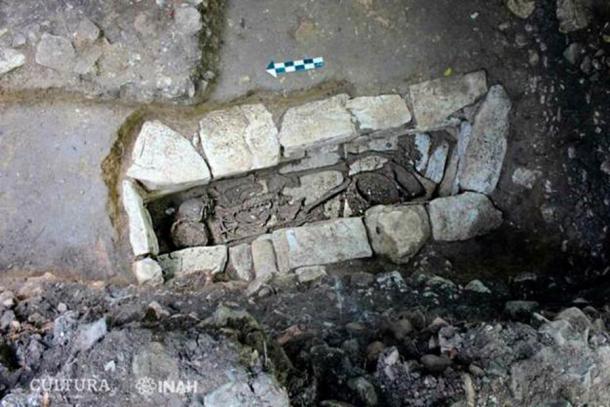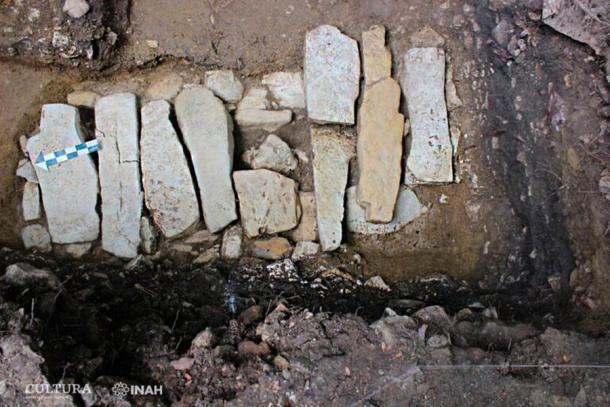
Archaeologists in Chiapas, Mexico Unearth Remains of Maya Noblewoman
The Chiapas branch of Mexico’s National Institute of Anthropology and History (INAH) has just reported a notable find in the heavily excavated Palenque Archaeological Zone in the southern part of the country, in what was once Maya territory. During salvage work taking place in what was to be the zone’s new restroom area, archaeologists uncovered a grave at a depth of six feet (1.80 meters) that contained the skeletal remains of a woman who was buried there sometime in the pre-Hispanic era.
The ancient city-state of Palenque, which was known as Lakamha in the Mayan language, was an important regional center in the Maya Empire during the latter’s Classical Era. Archaeologists are certain the remains belonged to a Maya woman, who would have lived sometime before the end of the eighth century AD, since all the ruins and relics found at Palenque date from the third century BC to that time.
Furthermore, because she was buried in a fairly extravagant tomb along with some fine grave offerings made from stone and obsidian, the archaeologists believe she would have been a member of the ancient Maya ruling elite. It is known that the city of Palenque was home to many members of the ruling class, based on its status as a major political and administrative center in the first millennium AD.
- New Study Verifies Aztec Manufacture of John Dee’s Obsidian Spirit Mirror
- Ancient Tattoos: Archaeologists find Blood and Pigments on 3,000-Year-Old Obsidian

The remains were found in a cist style grave. (INAH Chiapas)
Relics Instead of Restrooms
Under the supervision of INAH Chiapas Center, archaeologist Arnoldo Gonzalez Cruz, who has been involved in excavations at the site since the 1990s, and a team of technicians affiliated with the ongoing Palenque archaeological project were digging test pits in the area of the new restrooms when they uncovered the deeply buried ancient Maya grave. They weren’t certain if artifacts or ruins would be located at that spot, so it was a pleasant surprise to unearth a burial that contained the remains of a woman of exalted status from the long-lost but never forgotten Maya Empire.
The burial uncovered was far from simple. It included a type of tomb known as a cist, which is a sturdy container made from carefully carved stone blocks. The architectural style of the tomb was common in elite burials.
“The skeleton was in a recumbent position, one of the most common positions for the dead at Palenque,” Gonzalez Cruz told the news service Chiapas Paralelo. “Another very common feature is the orientation of the skull toward the north.”
The researchers noted the quality and nature of the grave goods and the tomb itself in determining that the woman must have belonged to Maya nobility. Another clue was the presence of jade stone inlays in some of the woman’s teeth. This type of inlay would only have been made available to high-status individuals with the means to pay for superior medical and dental services.
In addition to the elaborate tomb, the archaeologists also found evidence that a stone workshop had once existed in the same approximate location. In the ground above and around the tomb they also unearthed pieces of ceramic pottery and stone tools of various types. As of now the researchers aren’t certain if there is any connection between the items and the tomb or the elite woman buried there.
- Palenque – The Splendor of a Great Maya Metropolis
- Ritual Mask of Maya King Pakal the Great Unearthed in Mexico

This Maya noblewoman grave is not the first to be found at the site. (INAH Chiapas)
All Hail the Red Queen of Palenque!
Fascinatingly, this isn’t the first time that an archaeological team working under the supervision of Arnoldo Gonzalez Cruz has discovered the grave of a Maya noblewoman at Palenque.
In 1994, Gonzalez Cruz and associates opened a sealed tomb that had been found two decades earlier inside a Maya step-pyramid shrine known as Temple XIII. Inside the 12 foot by eight foot (3.8 meter by 2.5 meter) walled chamber they found a stone sarcophagus that contained the well-preserved skeletal remains of a wealthy woman who was covered in expensive and rare jewelry. The woman’s bounty of burial goods included an astounding collection of jade, pearls, shells, and bone needles, which were spread all across her body. Her chest was covered with obsidian and jade pieces, and on her head was placed a crown or headpiece made from flat, circular jade beads. A man who was apparently her servant was interred in the tomb with her, which revealed her status even more definitively.
The woman’s skeleton and everything buried with it were all covered in a red cinnabar powder, and for this reason she was labeled the Red Queen.
Dating procedures showed the woman had lived between the years 600 and 700 AD. While her burial chamber contained no inscription bearing her name, Gonzales Cruz eventually concluded she was Tz’ak-bu Ajaw, the wife of the legendary Maya king Pakal. This celebrated leader ruled the Maya Empire in the seventh century AD with great distinction, and when he died he was entombed (along with a cache of incredible treasures) inside a specially prepared pyramidal shrine known as the Temple of the Inscriptions.
Coincidentally (or perhaps not) Pakal’s tomb was constructed right next to Temple XIII, where the Red Queen was buried during the same time frame.
As for the newly discovered burial, it was not nearly as extravagant as that of the Red Queen. But it is clear the two women belonged to the same ruling class, and each was given an elite burial in recognition of their importance within Maya society as a whole.
An Ancient City of Delights and Revelations
Excavations have been going on at Palenque since the late 20th century. But this fertile site continues to produce intriguing relics and ruins that reveal it to have been one of the richest cities of the Classical Era of Maya civilization, which lasted from 300 to 900 AD.
Palenque is actually not one of the biggest Maya sites, but it is one of the most attractive. It contains some of the most artistically pleasing architecture, sculpture, and bas-relief carvings found anywhere in Maya territory. Archaeologists know Palenque as a site where multiple Maya secrets have been revealed, and the search for more fresh revelations is what keeps the same archaeological teams coming back year after year.
Top image: Grave with skeletal remains of a pre-Hispanic woman found at Palenque Archaeological Zone. Source: INAH Chiapas
By Nathan Falde















